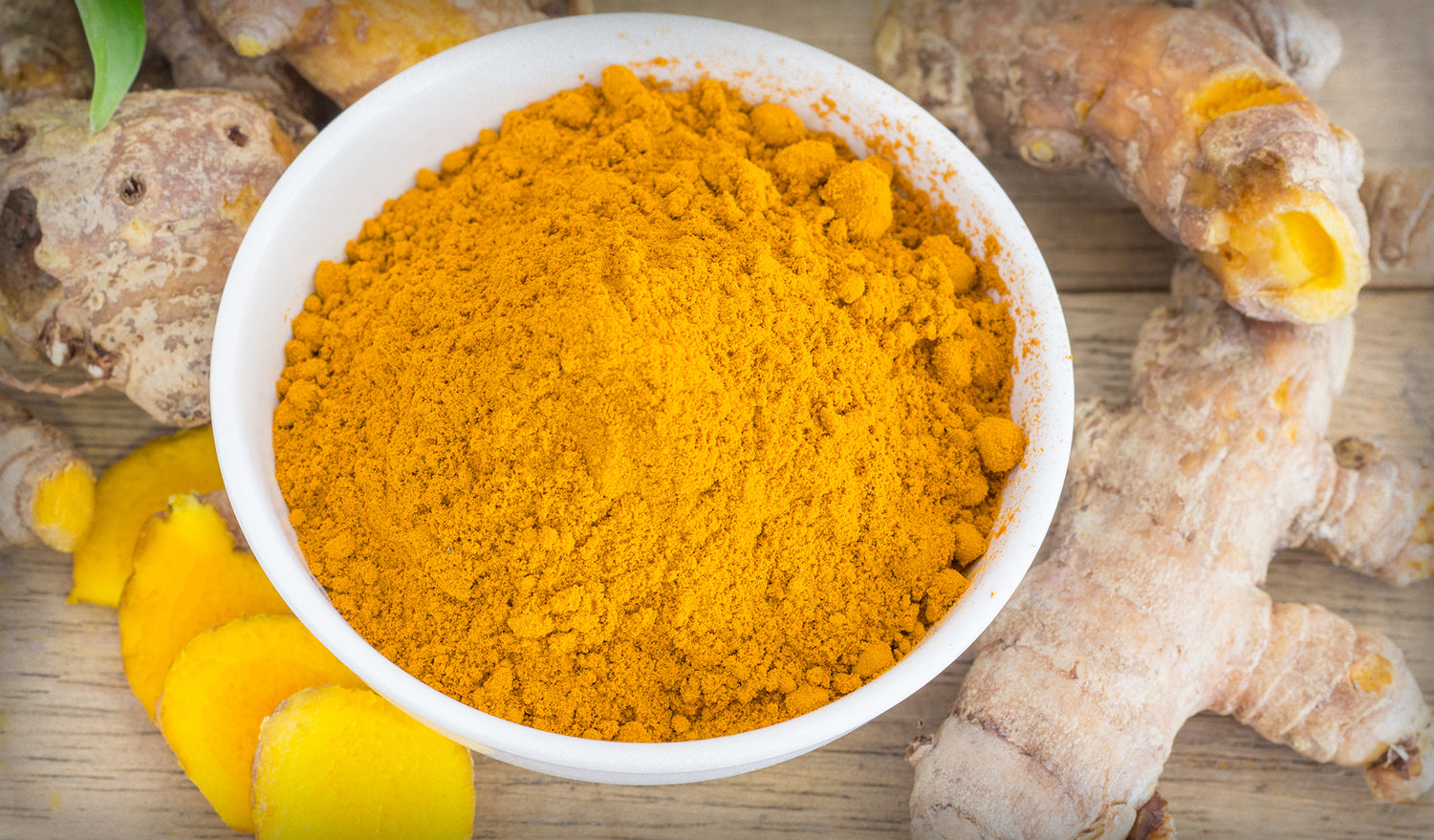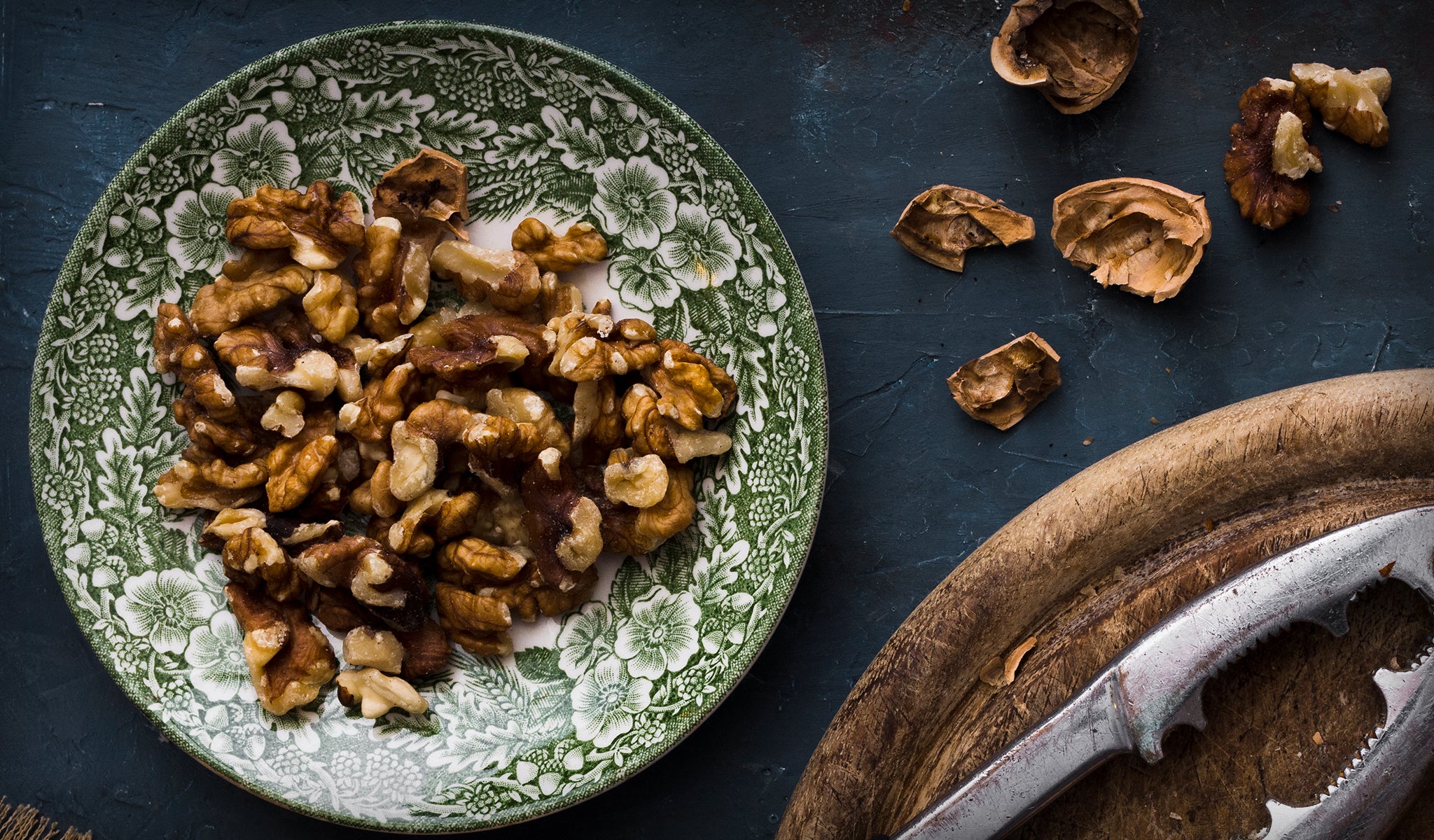SPICE IT UP WITH TURMERIC
Turmeric (Curcuma longa) is a member of the ginger family that is extensively cultivated in India, China, Indonesia, and other tropical countries. In cooking, the rhizome (root) is the part that is utilized. It has a tough brown skin and deep orange flesh, and is similar to ginger with smaller branched arms 1 to 1 1/2 inches around. It is usually cured (boiled, cleaned, and sun-dried), polished, and ground into a powder. Turmeric‘s flavor is peppery, warm, and bitter, while it’s fragrance is mild, yet slightly reminiscent of orange and ginger.
Turmeric powder was traditionally referred to as “Indian saffron”, as it’s deep yellow-orange color is reminiscent of saffron‘s. Turmeric is the major ingredient of curry powder and is also used in prepared mustard as a coloring agent. It is extensively used in a variety of foods for both its color and flavor.
HISTORY
A native of Indonesia and southern India, turmeric has been cultivated and harvested since 3000 B.C.E. Turmeric has played an important role in many traditional cultures throughout the East. It is still used today in rituals of the Hindu religion and as a die for holy robes. It is also a venerated constituent of the Ayurvedic pharmacopoeia.
Even though Arab traders introduced turmeric to Europe in the 19th century, it has become popular in western cultures only recently. Much of its newfound popularity is owed to the recent scientific study that has characterized it’s therapeutic abilities. India, Indonesia, China, the Philippines, Taiwan, Haiti, and Jamaica are the leading worldwide producers of turmeric today.
HEALTH BENEFITS
Turmeric has been and still is a key component of both the Chinese and Indian systems of medicine, where it is used as an anti-inflammatory agent and in the treatment of numerous conditions, including flatulence, jaundice, menstrual difficulties, bloody urine, hemorrhage, toothache, bruises, chest pain, and colic. Turmeric poultices are often applied locally to relieve inflammation and pain.
Curcumin, turmeric‘s yellow pigment, has demonstrated significant anti-inflammatory activity in a variety of experimental models. In fact, in numerous studies, curcumin‘s anti-inflammatory effects have been shown to be comparable to those of the potent drugs hydro-cortisone and phenylbutazone, as well as over-the-counter anti-inflammatory agents such as ibuprofen (Motrin). Unlike the drugs, which are associated with significant toxic effects, including ulcer formation, decreased white blood cell count, and intestinal bleeding, curcumin produces no toxicity.
Other clinical studies have further substantiated curcumin anti-inflammatory effects, including a clinical effect in rheumatoid arthritis. In this study, curcumin was compared to phenylbutazone. The improvements in the duration of morning stiffness, walking time, and joint swelling were comparable in growth groups. In a new human model for evaluating anti-inflammatory drugs, 400 mg of curcumin was comparable to 100 mg of phenylbutazone and 400 mg of ibuprofen.
Clinical studies have also substantiated that curcumin exerts very powerful antioxidant effects. Curcumin antioxidant actions enable it to protect healthy cells from free radicals that can damage cellular DNA and lead to cancer. This action is significantly beneficial to areas of the body such as the lining of the colon, where cell turnover is quite rapid - approximately every three days. Because of their frequent replication, mutations in the DNA of colon cells can result in the formation of cancerous cells much more quickly. Evidence is mounting that aspirin and other nonsteroidal anti-inflammatory drugs NSAIDs may prevent colorectal cancer. However in animal studies curcumin has been shown to inhibit colon cancer more effectively than aspirin at all stages, from initiation to promotion and progression.
Furthermore, curcumin helps the body to destroy mutated cancer cells, so they cannot spread through the body and cause more harm.
In addition to these preventative actions curcumin has also been shown to inhibit tumor growth by:
- Inhibiting epidermal growth factor (EGF) receptor sites: EGF stimulates cells to proliferate by connecting to receptors on the cells surface. About 2/3 of all cancers produce an abundance of these receptors, which make them highly sensitive to EGF. By reducing the number of EGF receptors, curcumin decreases the cells tendency to proliferate.
- Inhibiting angiogenesis: fibroblast growth factor is a protein that promotes the formation of new blood vessels to feed the growing tumor, curcumin inhibits production of this growth factor.
- Inhibiting nuclear factor Kappa beta (NF-kb): this is a protein that many cancer cells produce to block the signals commanding them to stop proliferating.
- Increasing the expression of nuclear p53 protein: this protein is essential for apoptosis, the normal process of cell “suicide”.
- Inhibiting growth promoting enzymes.
- Some of curcumin benefits benefits come from its known activity as an antioxidant, but curcumin also inhibits the formation of cancer-causing nitrosamines.
- Enhances the bodies production of cancer fighting compounds, such as glutathione.
- Promotes the livers proper detoxification of cancer-causing compounds.
- Prevents overproduction of cyclooxygenase 2 (COX-2), an enzyme that may contribute to the development of tumors.
While more human studies are needed on the use of curcumin in cancer treatment, the experimental and preliminary evidence is quite encouraging. Experimental (test tube) studies have found that curcumin fights tumors arising from prostate, breast, skin, colon, stomach, and liver cancers.
In addition to protecting against cancer, turmeric may be able to help in the prevention of heart disease, as well as degenerative neurological diseases such as Alzheimer’s and Parkinson’s diseases and multiple sclerosis. Regarding heart disease, turmeric not only helps to lower cholesterol, it also prevents the oxidation of cholesterol. Since oxidized cholesterol is what damages blood vessels and builds up in the plaques that can lead to a heart attack or stroke, preventing the oxidation of new cholesterol may help to reduce the progression of atherosclerosis and diabetic heart disease.
Regarding its potential as a brain-protective agent, population studies showed that in elderly Indian populations, in whose diet turmeric is a common spice, levels of neurological disease, such as Alzheimer’s, were very low. In addition, studies have shown that curcumin slows the progression of Alzheimer’s and multiple sclerosis in mice.
SELECTION & STORAGE
Turmeric is available as a ground powder but, like ginger, is available as the fresh rhizome. Fresh turmeric should be free of dark spots and be crisp. It may be stored in the refrigerator, where it will keep for one month. Alternatively, it can be chopped or diced and stored in an airtight container for up to three months.
Since the color of turmeric powder varies among varieties, it is not necessarily a criteria of quality. However, try to select organically grown dried turmeric, since organically grown spices are much less likely to have them irradiated. Turmeric powder should be stored in a tightly sealed container in a cool, dark, dry place, where it will keep for up to one year.
Fresh turmeric rhizome is available from Asian markets and health food stores. Curcumin containing products are also available in health food stores.
USE TIPS
Since turmeric's deep yellow and orange color can easily stain, avoid getting it on clothing. To avoid a permanent stain, quickly wash any affected area with soap and plenty of water. Depending upon how much you plan on handling, it might be a good idea to wear latex gloves when preparing food with turmeric.
Turmeric is a spice that is heavily relied on in cuisines of southeast Asia, India, and Mexico, as it is a primary ingredient in curry and chili powders. Other popular uses for turmeric are for adding color to any green dish as well as to complement any recipe in which ginger appears.
RESOURCES- The Encyclopedia of Healing Foods by Michael Murray, ND



